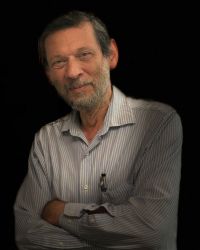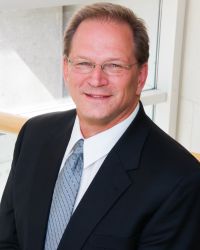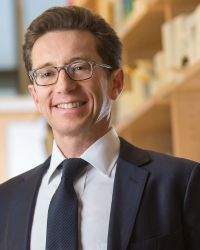Case Western Reserve University is home to outstanding faculty who are dedicated to excellence in teaching, research, and mentorship, fostering an environment of academic growth and innovation for their students.
Each year, the university bestows the title of Distinguished University Professor—the highest honor the university grants to faculty—upon those who have exceptional records of scholarship and have made significant contributions to their fields, further enhancing the intellectual vibrancy of the university community.
This year is no different, as three faculty members have been named Distinguished University Professors: Hillel Chiel, Mitch Drumm and Jonathan Stamler. Discover more about their achievements below.

Hillel Chiel
When Hillel Chiel was about 10 years old, he took apart a mechanical clock that wasn’t working. Looking at the pieces scattered around, he realized his mother would not be happy with the mess, so he put them back together—and the clock functioned! The experience sparked a lifelong enthusiasm for learning how things operate.
A professor in the College of Arts and Sciences’ Department of Biology —with secondary appointments in the departments of neuroscience and biomedical engineering—Chiel is now being recognized as a 2024 Distinguished University Professor, Case Western Reserve’s highest designation for faculty.
Chiel’s impact is most felt through his extensive collaborative interdisciplinary research. His work is widely recognized for helping scholars understand the mechanisms of adaptive behavior through the use of computational modeling and experimental approaches to the research.
“I feel a great sense of gratitude,” Chiel said, reflecting on his latest recognition. “There were years earlier in my career during which my attempts to convince my fellow neuroscientists to focus on biomechanics and modeling were regarded as somewhat strange. I am happy to see that many others are now pursuing research that incorporates both the brain and the body.”
Chiel believes collaborations are critical to tackling difficult problems. He set the standard for this in 1997 when the prestigious journal Trends in Neurosciences published, “The Brain Has a Body: Adaptive Behavior Emerges from Interactions of Nervous System, Body and Environment,” a groundbreaking review he co-authored with computer scientist Randall Beer.
“Collaborators must be treated as close friends, with mutual respect, trust and enthusiasm for each other’s interests and goals,” Chiel said.
In other projects, Chiel worked with biomedical and mechanical engineers to develop a sequence of increasingly realistic models of soft-bodied structures. They created the first model of a muscular hydrostat—structures such as tongues, trunks and tentacles—using the tongue of a reptile. This work led to a turning point in the development of soft robots (biorobotics), as well as flexible-legged robots that can traverse complex terrains.
In his most recent paper published in PNAS Nexus, Chiel—along with CWRU’s Roger Quinn, Greg Sutton from University of Lincoln (England) and Nick Szczeciński from West Virginia University—developed a framework for understanding how the four major forces acting on animal limbs are used during locomotion as a function of limb length and speed. He describes the new analysis as a single quantity that can capture essential features of locomotion for animals ranging in size from fruit flies to elephants.
“Dr. Chiel is a consummate scholar, a deep thinker, an influential writer, a dedicated mentor, an inspiring teacher, a selfless advocate for the goals of the university, and—above all—an outstanding scientist,” said Lee Thompson, interim dean of the College of Arts and Sciences.
“I hope that my focus on taking things apart and trying to put them back together again—using both analysis and synthesis—inspires other investigators to do the same,” Chiel said. “I also hope that my ideas about how important it is to consider the nervous system in the context of the body will continue to influence others for some time to come.”

Mitch Drumm
Internationally recognized for his pioneering research on cystic fibrosis (CF)—a rare genetic disorder that primarily affects the lungs—Mitch Drumm has played a seminal role over the past nearly 40 years in discovering and defining key aspects of the origin and management of the disease.
Now, Drumm—the Connie and Jim Brown Professor in Cystic Fibrosis Research at Case Western Reserve University School of Medicine—has earned another title: Distinguished University Professor.
Early in his career, Drumm was co-discoverer of the gene that causes cystic fibrosis (CFTR) while working on his doctorate under Francis Collins, later the longest-serving director of the National Institutes of Health (NIH). The work is credited as a major motivator for the initiation of the Human Genome Project.
“In addition to his personal scientific contributions,” wrote Collins, in a letter nominating Drumm for the distinguished professorship, “Mitch is probably the most selfless genetics researcher that I know. His door is always open. He is always looking for ways to help others, and routinely passes up the chance to be in the spotlight himself.”
Drumm was also one of the earliest investigators to explore gene therapy for inherited human genetic disorders. His work on viral-based vectors, along with the efforts of many subsequent investigators, has since evolved into full-fledged efforts to treat CF and many other conditions with gene therapy.
Drumm’s research also contributed to development of the ultimately successful drug Trikafta, which has significantly extended the health span and lifespan of 90 percent of individuals with CF.
“[Drumm’s contributions] have revolutionized the treatment of CF,” wrote Gary Cutting, professor of genetic medicine, pediatrics and medicine at Johns Hopkins University, in his nomination letter. “[Drumm] was also one of the first investigators to recognize the importance of locating genetic modifiers of cystic fibrosis.”
For his career-long dedication combating the disease, Drumm was recognized with the highest scientific honor given by the Cystic Fibrosis Foundation—the Paul di Sant ‘Agnese Distinguished Scientific Achievement Award.
In 2015, recognizing the need for a hub of research activity dedicated to rare genetic diseases in children, Drumm initiated the formation of CWRU’s Research Institute for Children’s Health and serves as its director.
“The institute has served as a remarkable catalyst for creative research ideas—and also supports an extraordinary training environment for postdocs, graduate students, and others,” wrote Stan Gerson, dean of the School of Medicine.
Drumm has authored or co-authored over 140 manuscripts, presentations, reviews, and book chapters, delivered over 100 invited lectures, and earned six patents.
“Case Western Reserve has been an ideal environment to carry out my work, and I am appreciative of my colleagues—many of whom I’ve worked with for more than 30 years,” said Drumm, also a professor of pediatrics at the medical school. “Our research group has made a significant impact in CF research, and it is the family-like, group mentality that has made that possible.”

Jonathan S. Stamler
Throughout his nearly four-decade career, groundbreaking physician-scientist and researcher Jonathan Stamler has searched for solutions to complex medical problems, advanced understanding of human health and improved patients’ lives through a range of discoveries, devices and new treatments.
In recognition of his accomplishments and enduring impact, Stamler—the Robert S. and Sylvia K. Reitman Family Foundation Distinguished Professor of Cardiovascular Innovation at the School of Medicine and president of the Harrington Discovery Institute at University Hospitals Health System—will be honored as a Distinguished University Professor at Case Western Reserve University.
Among Stamler’s discoveries is protein S-nitrosylation—a biochemical process that can regulate cell signaling pathways, protein functions, gene expression and enzyme activity. Dysregulation of protein S-nitrosylation has been implicated in many diseases, such as cardiovascular disorders, neurodegenerative diseases, inflammation and cancer.
“Protein S-nitrosylation represents a paradigm shift in our thinking about mechanisms by which nitric oxide elicits its physiological effects … Stamler’s discoveries benefit humankind in their therapeutic applications,” wrote Lou Ignarro, Nobel Laureate and professor emeritus of pharmacology at the UCLA School of Medicine, in a letter nominating Stamler for the distinguished professorship.
Added Ignarro, “As a prominent scientist myself … I must confess that I’ve never seen as outstanding a CV as that of Dr. Stamler.”
Many of Stamler’s discoveries have a direct application to improving the understanding of pathophysiology and disease. For example, Stamler’s work established that hemoglobin in red blood cells not only carries oxygen and carbon dioxide to support cellular respiration, but also carries a third gas, nitric oxide, which is critical for autoregulation of blood flow through tissue microcapillaries. His findings have also shown that gut bacteria can use nitric oxide to change how bodies work, affecting growth and development.
“I am impressed by his vision and creativity and by his seemingly boundless energy,” wrote Michael Welsh, an investigator at the Howard Hughes Medical Institute, in his nomination letter. “His discoveries have large implications for understanding fundamental biology and for insight and therapy of disease. He is an international leader in medicine.”
With a reputation for innovation and entrepreneurship, Stamler has founded nine biotech ventures, alongside institutes, medical societies and investment funds. His scholarly output is equally impressive, with nearly 400 manuscripts authored or co-authored, along with 225 patents—work that has resulted in the development of two U.S. Food and Drug Administration-approved drugs and multiple medical and wearable technologies by companies under his guidance.
For the Distinguished University Professorship, multiple nominators cited Stamler’s natural leadership and ability to inspire and energize others, particularly emerging scientists and researchers.
“Throughout my career, I’ve strived to push the boundaries of knowledge, to challenge conventional thinking, and ultimately, to make a lasting difference. It’s a profound honor to be recognized as a Distinguished University Professor at Case Western Reserve,” said Stamler. “I look forward to continuing my journey of exploration and discovery.”

